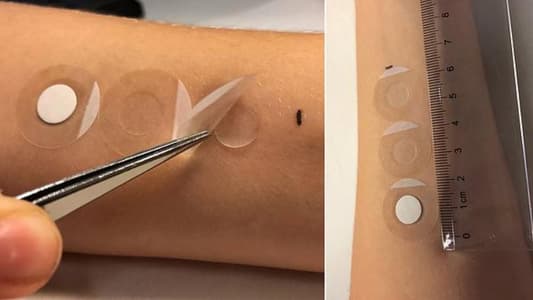A 'plaster' placed over moles may one day tell doctors whether they are cancerous or not, scientists hope.
Researchers in Sweden are in the process of making the tool, which will search for molecules released by tumours.
Malmö University experts hope the plaster-like patch will analyse suspicious moles and be able to diagnose cancer within minutes.
It could spell the end to biopsies, which can feel like a pinch, cause bleeding and leave patients waiting weeks for a diagnosis.
The scientists are still in the process of finding tiny fragments that skin cancers leave behind, which could theoretically be picked up.
Sebastian Björklund, one of the researchers, told MailOnline that they have already identified some 'promising candidates'.
However, they still need to prove that a patch could even capture molecules given off by tumours. Results are not expected until 2021.
Following that, the researchers plan to test the plaster on healthy volunteers and skin cancer patients to prove it can spot tumours.
They are currently working on creating a prototype of the plaster. They also still need to find a way to analyse the molecules at the same time.
Professor Johan Engblom, one of the scientists behind the projects, hopes it would give almost immediate results.
Professor Tautgirdas Ruzgas, one of the research team, said: 'We are hoping it will be a lot easier to detect skin cancer at an early stage.
'We imagine a plaster, or an equivalent, placed on the area of skin suspected to be developing cancer in order to collect molecules for analysis.'
The scientists are working alongside pharmaceutical firms to produce the plasters, and the components that could spot the molecules.
They have yet to determine a rough cost - but are aiming for it to be 'significantly lower' than a biopsy, thought to cost around £395 ($500).
Skin cancer is one of the most common types of the disease. It is mainly caused by over-exposure to UV rays.
Rates of melanoma - the deadliest form - have spiralled by 45 per cent in the past decade, according to figures.
Currently, the main way of spotting it is through a biopsy, a minor procedure where a sample of tissue is surgically taken and examined.
Biopsies are used to confirm a skin cancer diagnosis, but cause bleeding and a raised risk of blood infections.
The NHS warns that it can take several weeks before patients receive the results of a biopsy, leaving many riddled with anxiety.
And the procedures can also be costly, with the health service spending millions of pounds on biopsies each year.
Dr Adil Sheraz, consultant dermatologist and British Skin Foundation spokesperson, told MailOnline: 'The idea seems very interesting.
'Currently the only way to be certain if a lesion is cancerous is by either cutting it out or by taking a biopsy from it.
'If a less invasive technique could be developed to confirm the nature of a lesion then it would save the patient from undergoing a procedure and have significant impact on costs.'
'It seems to be very early stages and I would look forward to seeing the preliminary results.'
Figures suggest more than 100,000 people in the UK are diagnosed with skin cancer each year. In the US, around 9,500 are diagnosed every day.






TWEET YOUR COMMENT